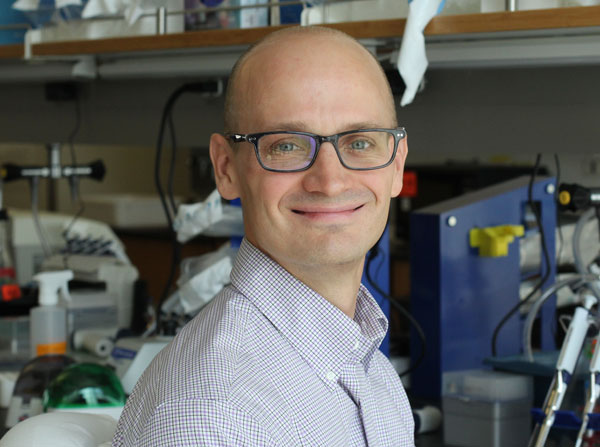
Joseph T. Rodgers (Photo by Cristy Lytal)
“My dad is a chemical engineer, and he’s always been an outdoorsy person,” said Rodgers. “You just go off in the woods and all that goes along with that — fishing, catching frogs and turtles, and stuff like that. That was certainly how everything started.”
Rodgers grew up 30 miles from Cleveland in a rural area that he describes as “where the suburbs meet the forest.” He attended Catholic schools, and double majored in biology and chemistry and gained his first research experience at the Jesuit-run John Carroll University. To this day, the philosophy of the Jesuits influences Rodgers, although he no longer considers himself formally religious.
“The main philosophy of the Jesuits is service,” he said. “My interpretation of service is expanding knowledge through research and education. That’s a main driving force of why I’m here today. I had a lot of really great professors in college and in graduate school who really inspired me, who really made this science interesting. And that’s what I want to be while I’m here.”
He continued his commitment to expanding knowledge by attending graduate school at The Johns Hopkins University School of Medicine, where he earned a PhD in biochemistry, cellular and molecular biology.
Rodgers was the first graduate student in the laboratory of Pere Puigserver, who was just starting out. Together, they published a slew of papers about metabolism, focusing on how the body regulates its energy during feeding, fasting or exercise.
“I think metabolism is fascinating,” said Rodgers. “It’s where biology and chemistry meet. What your body can do is largely governed by where and how it gets the energy to do it.”
When Puigserver moved his laboratory to Harvard Medical School, Rodgers followed and completed his first postdoc. He then did a second postdoc in the laboratory of Tom Rando at the Stanford School of Medicine, where he began studying the signals the body uses to regulate stem cells’ metabolism and how this affects stem cells’ ability to make and repair tissue.
“The goal of trying to identify the metabolic instructions the body gives to stem cells is very clearly for therapeutic purposes and translational medicine,” said Rodgers. “So, for example, if you understand the signals that are responsible for making more skin, then you can translate this into a therapy to give to burn victims to help them heal better, or you can use this to engineer tissue to transplant into patients.”
One recent finding carries clear potential for therapeutic application: Rodgers’ team found that injury triggers the release of a molecule into the blood stream that puts stem cells throughout the body into a “high-alert” state, primed to repair and heal as needed. Eventually, doctors could prescribe some version of this molecule to patients before surgery, to soldiers before combat or to others likely to experience injury.
While he’s not in the laboratory, Rodgers maintains a garden in his new Mount Washington home. As a self-proclaimed “glutton for punishment,” he also likes doing aerial and acrobatic yoga, running marathons and participating in Ironman triathlons — which happen to have a connection his research.
“Strangely, one of the effects of exercise is that it also seems to put stem cells into this alert state,” he said. “This is just a phenomenon at this moment. It’s really unclear how this happens or if it is a beneficial aspect of exercise.”
As a new assistant professor at USC, Rodgers is excited to continue uncovering the signals that instruct stem cells to build and repair tissue.
“This is a research area that’s ripe for somebody to tackle this question,” he said. “But also, I really hope to be an inspiring professor — whether it’s inspiring the students to enter research, or to be teachers themselves, or to be authors, or to go on to do whatever they want. There are a lot of really interesting things about science, and I just love this. And I hope to convey that to the students.”
By Cristy Lytal